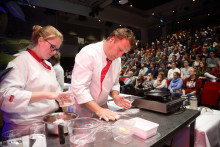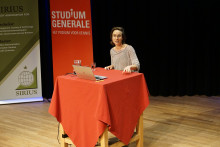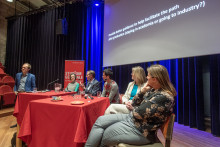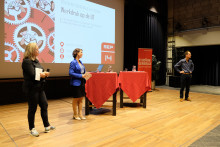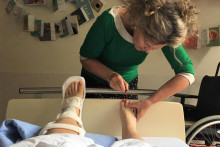The lecture took place yesterday, 5th of October 2015, in Agora at the UT and it was conducted by Prof. Brenner over Skype. Although the word 'lecture' doesn´t quite describe the event, as it also included a live cooking demonstration by chef Niels Schuur from the Faculty Club and a constant interaction with the audience.
Understanding physics of cooking
'The discovery of a new dish confers more happiness on humanity, than the discovery of a new star,' Brenner began his talk with a quote by a famous 19th century gastronome Brillant-Savarin. 'However, when a new star is discovered, it´s celebrated and it´s seen as a great progress. But dishes we eat on daily basis, we don´t understand at all.'
On that note and with the goal of teaching science to non-scientists, Brenner helped to start a course of 'Science of cooking' at Harvard. 'The course became popular beyond expectations. It always features a famous chef illustrating some aspects of cooking. Students also make recipes in the lab and as the final step, they can eat their lab.' Not many other courses can offer that.
Liquid turns into a solid
This course, just as yesterday´s lecture, discusses scientific and mathematical topics that are central to cooking and describes how these ideas constantly appear during everyday cooking. One of these topics is packing, which Brenner demonstrated by asking volunteers to whisk egg whites. After some vigorous whisking, the originally liquid eggs turn into a foamy, solid substance. 'Isn´t this amazing? You made a solid our of liquid and air!'
How is this possible? An examination of the newly formed substance under a microscope reveals that the it is made of tiny bubbles. The smaller the bubbles, or droplets, the thicker and more solid the matter becomes.
Magical eggs
This process of turning a liquid into a solid will naturally not work with everything - you can whisk water as long as you like, but it will not turn into a foam, less alone a solid substance. Why does it work with eggs then? Egg whites contain globular proteins. The long protein molecule is folded and curled up. When egg whites are whisked, they are introduced to air and the protein molecules uncurl. Once that happens, they can bond with each other and create a network that holds the air bubbles in place.
Similar process happens when eggs are heated. Unfolded proteins can coagulate and they stick to each other, changing the state of the substance. Eggs are, in fact, very sensitive to temperature. There is only a 13°C difference between a completely raw egg and an egg that is absolutely solid. That´s why making an egg just the way you like it can be a nightmare.
Frozen marshmallows
Professor Brenner and the Faculty Club team showed more interesting examples of science in cooking. One of them, which the audience also got to taste, were marshmallows frozen in a liquid nitrogen (which has the temperature of -196°C). Even though dipping any other food into a liquid nitrogen might cost you your tongue, marshmallows prepared this way can be safely eaten. 'The amount of heat marshmallows can store is very low,' explained Brenner. 'That´s because they consist of mainly air. If there was any water in them, you would burn your tongue.' So perhaps don´t try this at home.
If you are interested in the topic, but don´t have the chance to study at Harvard, Professor Brenner is also involved in an online course of 'Science and Cooking', available to anyone.


